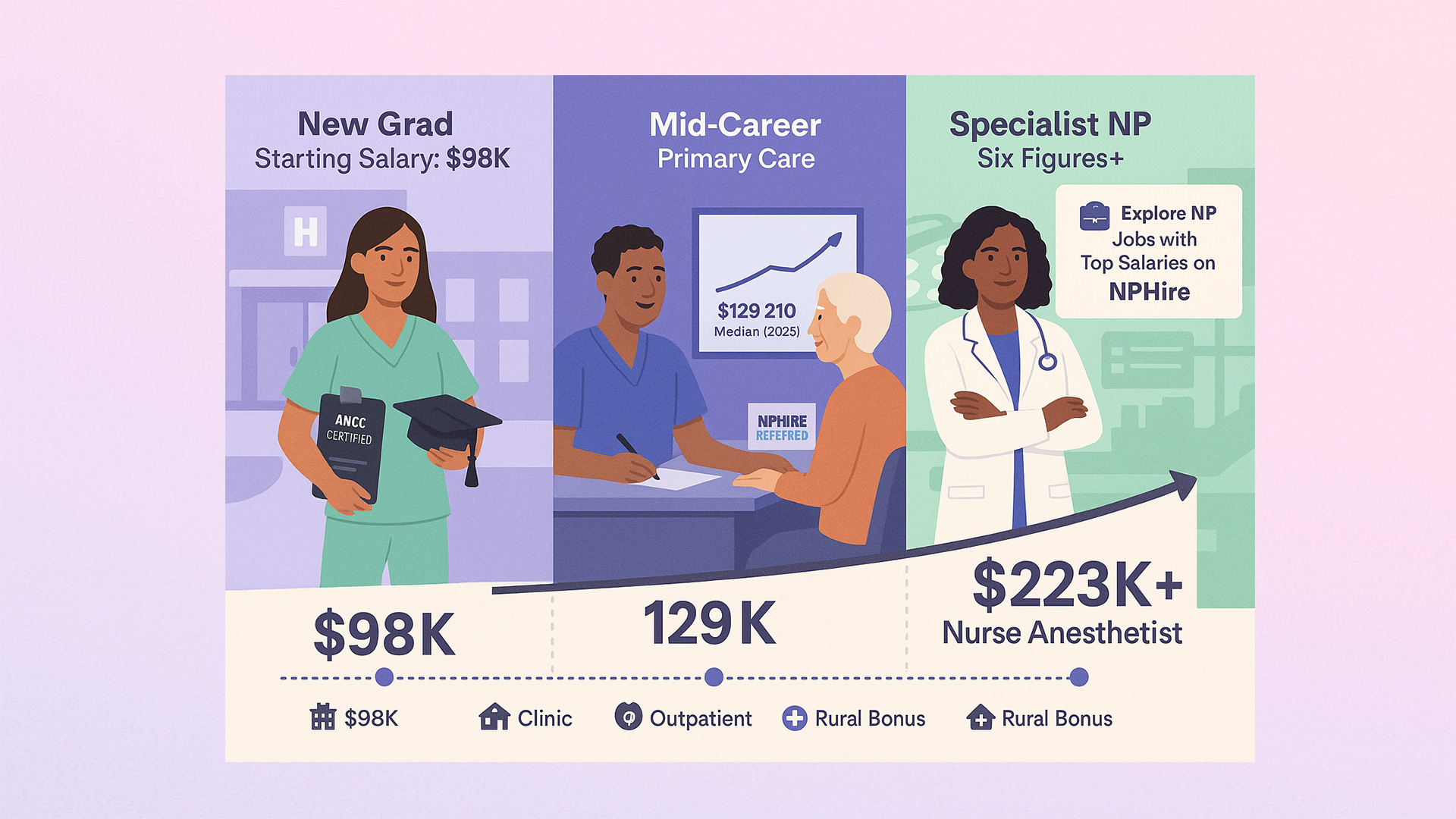TL;DR: 2025 Nurse Practitioner Salary Highlights in 5 Fast Facts
- Strong earning potential – Nurse practitioners earn a median annual salary of $129,210 according to the Bureau of Labor Statistics, with nurse anesthetists commanding six figures at $223,210+ and psychiatric mental health specialists exceeding the national average across healthcare industries.
- New graduates secure competitive wages – Entry-level nurse practitioner salary ranges from $98K–$130K+, providing immediate return on nursing education investment with higher salary than registered nurses and most other health practitioners.
- Geographic factors affect pay – High-paying states like California, New York, and Washington lead wage statistics, while southern states offer competitive practitioner salary packages through loan forgiveness and signing bonuses for primary and preventive care positions.
- Work environment impacts income – Surgical hospitals, outpatient centers, and specialty facilities provide higher annual wages than physicians' offices, though all nurse practitioners' work settings exceed registered nurses' pay across primary care and critical care specialties.
- Employment outlook drives demand – With 46.3% job growth projected by Bureau of Labor Statistics due to aging population needs, nurse practitioners have exceptional job opportunities to specialize in mental health, home health care services, and other high-demand areas where employers compete for qualified workers.
Are you ready to discover why nurse practitioners consistently rank among the highest-paid healthcare professionals in America?
If you're a registered nurse considering the leap to advanced practice or a new graduate wondering whether your nursing education investment will truly pay off, the numbers speak for themselves. According to the most recent data from the Bureau of Labor Statistics, nurse practitioners earn a median annual salary of $129,210—nearly triple the national average across all occupations and significantly higher than most other health practitioners.
This represents a transformative career shift for registered nurses who have spent years providing excellent patient care at lower wage levels. The entry-level nurse practitioner salary outlook is particularly encouraging:
- New graduate nurse practitioners typically begin their careers earning between $98,520 and well above $130,000
- Geographic location and specialty choice significantly impact starting compensation
- Six-figure earning potential is standard across most regions and practice settings
The nurse practitioner salary landscape offers compelling opportunities across multiple specialties. Whether you're interested in primary and preventive care or specialized fields, advanced nursing practice provides substantial income growth potential:
- Nurse anesthetists command the highest wages with a median salary of $223,210
- Psychiatric mental health specialists benefit from growing demand and competitive pay
- Critical care specialists and nurse midwives working in surgical hospitals enjoy premium compensation packages
Your future earning potential extends far beyond base pay considerations. Several key factors influence your annual wage and career trajectory:
- Geographic location impacts compensation significantly, with some paying states offering substantial premiums
- Southern states provide competitive packages through loan forgiveness programs and signing bonuses
- Work environment varies from physicians' offices to home health care services, each with distinct salary ranges
- Experience level and specialty certifications directly correlate with higher earning potential
With the aging population driving unprecedented demand for healthcare services and most states expanding nurse practitioner scope of practice, the employment outlook has never been stronger. At NPHire, we connect ambitious nurse practitioners with healthcare employers offering competitive salaries, comprehensive benefits, and career growth opportunities that align with your professional goals and financial aspirations.
In this article, we'll dive deeper into the current nurse practitioner salary landscape, examining the latest wage statistics from the Bureau of Labor Statistics and exploring what new graduates can realistically expect to earn across different healthcare industries.
Current Nurse Practitioner Salary Landscape
National Overview
The nurse practitioner profession stands as one of healthcare's most financially rewarding career paths, with wage statistics from the Bureau of Labor Statistics painting an exceptionally promising picture for both current practitioners and those considering this advanced nursing practice.
When examining how nurse practitioners compare to other health practitioners, the compensation advantage becomes even more apparent. While registered nurses earn a median annual salary of $93,600, the transition to advanced practice represents a 38% salary increase. This places nurse practitioners in an elite category alongside other high-earning healthcare professionals:
- Physician assistants earn a median of $133,260, placing them slightly above NPs
- Nurse anesthetists command the highest wages at $223,210 due to their specialized skills
- Nurse midwives earn $128,790, demonstrating consistent six-figure potential across NP specialties
The employment outlook reinforces these positive salary trends with unprecedented growth projections. The Bureau of Labor Statistics forecasts a remarkable 46.3% job growth for nurse practitioners through 2033, dramatically outpacing the 6% growth expected for registered nurses and most other occupations. This explosive demand stems primarily from the aging population requiring increased healthcare services and the ongoing shift toward preventive care models where nurse practitioners excel.
Healthcare industries across the board recognize the value nurse practitioners bring to patient care delivery. From primary and preventive care settings to specialized psychiatric mental health services, employers are competing for qualified NP talent, naturally driving wages upward. The combination of scope of practice expansions in most states and growing recognition of NP clinical effectiveness continues to strengthen the profession's earning potential.
Entry-Level & New Graduate Reality
New graduate nurse practitioners enter a remarkably strong job market with entry-level nurse practitioner salary expectations that consistently exceed six-figure thresholds. According to the American Association of Nurse Practitioners, the base salary for NPs averages $111,000, providing new graduates with immediate financial security and rapid return on their master's degree investment.
The salary range for entry-level positions varies by geographic location and practice setting, but even the most conservative estimates place new graduate earnings well above national averages. The 10th percentile of nurse practitioners earn $97,960, while those in higher-paying regions and specialties can expect starting salaries exceeding $130,000. This represents a transformative income increase for registered nurses transitioning to advanced practice roles.
Regional variations in entry-level compensation reflect local market conditions and cost of living factors. California leads paying states with opportunities for new graduates to earn substantially above the national average, while southern states often compensate for lower base salaries through comprehensive benefits packages, loan forgiveness programs, and signing bonuses that enhance total compensation.
The nursing education investment pays dividends almost immediately upon graduation. Unlike many professional fields where entry-level positions require years to reach comfortable income levels, nurse practitioners begin their careers with salaries that support financial stability and rapid student loan repayment. This quick return on educational investment makes advanced nursing practice an increasingly attractive option for registered nurses seeking both professional growth and financial advancement.
Factors That Shape Your Nurse Practitioner Earning Potential
Several key variables determine your annual wage as a nurse practitioner, and understanding these factors enables strategic career planning that maximizes your compensation throughout your nursing practice journey. While the national average provides a solid foundation, your actual practitioner salary will vary based on decisions you make about where to work, what specialty to pursue, and how to structure your career advancement.
Geographic Impact: Location Drives Compensation Differences
Where you choose to practice as an NP significantly influences your earning potential, often superseding other considerations like experience level or specialty focus. The wage statistics reveal substantial regional variations that reflect local market conditions, cost of living factors, and healthcare demand patterns.
California consistently ranks among the highest-paying states, with nurse practitioners earning a median salary of $166,610 according to Bureau of Labor Statistics data. However, practitioners must weigh this premium against the state's elevated living costs when calculating real purchasing power. Other top-performing regions include:
- Washington state offers competitive compensation at $143,620 median salary with more reasonable living expenses
- New York provides strong earning potential with median wages of $148,410, particularly in metropolitan areas
- Massachusetts and Oregon round out the top-paying states with salaries exceeding $138,000
Southern states typically present a different value proposition, offering lower base salaries but compensating through comprehensive benefits packages, loan forgiveness programs, and significantly reduced living costs. Rural areas across all regions often provide additional incentives like signing bonuses and housing assistance to attract qualified nurse practitioners to underserved communities.
Practice Setting: Your Work Environment Determines Pay Scale
The healthcare setting where nurse practitioners work dramatically impacts both annual salary and total compensation packages. Different employers and industries offer varying pay structures that reflect patient acuity, revenue models, and operational demands.
Outpatient care centers lead the compensation, with a median salary of $140,000-$145,000, followed closely by hospitals at $137,790. These settings typically serve higher-acuity patients requiring specialized skills and often provide comprehensive benefits packages including health insurance, retirement contributions, and continuing education allowances.
Physicians' offices represent the largest employment sector for nurse practitioners, offering median salaries of $129,820. While these positions may pay slightly below specialty settings, they often provide better work-life balance, regular business hours, and opportunities for long-term patient relationships in primary and preventive care.
Home health care services and specialty psychiatric facilities offer unique compensation models, with some positions providing hourly wage structures that allow practitioners to control their income through scheduling flexibility and overtime opportunities.
Specialization: High-Demand Areas Command Premium Compensation
Your choice of specialty significantly influences earning potential, with certain fields commanding substantial salary premiums due to complexity, demand, and required expertise. Nurse anesthetists represent the highest-earning segment at $223,210 median salary, reflecting the specialized nature of anesthesia care and extensive additional training requirements.
Psychiatric mental health nurse practitioners benefit from the growing demand for mental health services, often earning 15-20% above general practice rates. Critical care specialists working in intensive care units and emergency departments typically receive premium wages due to patient acuity and the specialized skills required for acute care management.
Primary care nurse practitioners, while earning at or slightly below the national average, enjoy exceptional job security and opportunities for meaningful patient relationships. The aging population continues to drive demand for preventive care services, making this specialty increasingly valuable to healthcare employers seeking long-term provider relationships.
Securing Your Future in High-Paying Nurse Practitioner Roles
The nurse practitioner salary landscape presents exceptional opportunities for both new graduates and experienced registered nurses ready to advance their careers. With median annual wages of $129,210 and entry-level positions consistently offering six-figure compensation, the financial rewards of nursing education investment are both immediate and substantial.
The employment outlook for nurse practitioners has never been stronger. With 46.3% projected job growth through 2033, driven by the aging population and expanding healthcare needs, demand for qualified practitioners continues to outpace supply across physicians' offices, hospitals, and home health care services. This market dynamic ensures that nurse practitioners will continue to hold a position among the highest-paid healthcare professionals.
For current nursing students, completing your clinical rotations on schedule directly impacts your earning timeline:
- Every semester delay in graduation translates to thousands in lost income opportunity
- Securing quality preceptors remains a significant challenge for most NP students
- Strategic planning for clinical placements is essential for on-time graduation
If you're struggling to secure quality preceptors for your clinical placements, NPHub specializes in connecting NP students with vetted preceptors, handling the complex coordination that often derails graduation timelines.
Whether you're a new graduate entering the job market or an experienced practitioner seeking to maximize your salary potential, the right career opportunities make all the difference. Healthcare employers are actively competing for qualified nurse practitioner talent, offering competitive compensation packages, signing bonuses, and comprehensive benefits that extend far beyond base salary considerations.
Ready to discover your next high-paying nurse practitioner opportunity?
NPHire connects ambitious NPs with healthcare employers offering competitive salaries and career growth you deserve. Our platform eliminates the frustration of traditional job searches by matching you with positions that align with your specialty interests, geographic preferences, and salary expectations. Start exploring premium NP opportunities today and take the next step toward maximizing your earning potential in this rapidly growing field.
Frequently Asked Questions
1. Do I need a Doctor of Nursing Practice (DNP) degree to earn top salaries?
A master's degree remains sufficient for most high-paying NP positions. While DNP degrees may provide slight advantages for executive and academic roles, specialty certifications often deliver more immediate salary benefits in clinical practice. The key is choosing the right specialty and gaining experience rather than pursuing additional degrees. Focus your educational investment on areas with proven salary returns in your target practice setting.
2. How do NP salaries compare to physician assistant salaries, and why should I choose the NP path?
Physician assistants earn a median of $133,260, placing them slightly above the NP median of $129,210. However, nurse practitioners enjoy greater practice autonomy in most states, stronger job growth projections (46.3% vs. lower PA growth), and diverse specialty options. NPs can also prescribe medication independently in most states and have clearer pathways to leadership roles in healthcare organizations.
3. What's the difference between hourly wage and salary positions for nurse practitioners, and which pays more?
Many nurse practitioners work salaried positions with annual wages ranging from $98,000-$200,000+, while others prefer hourly wage structures that typically range from $45-$75 per hour for standard clinical work. Hourly positions in urgent care, home health care services, or per diem hospital work can often exceed six figures annually if you maintain full-time hours. The choice depends on your preference for scheduling flexibility versus guaranteed income and benefits packages.
4. How does the aging population specifically impact nurse practitioner job opportunities and salaries?
The aging population drives unprecedented demand for primary and preventive care services, creating more job opportunities for nurse practitioners across all specialties. As baby boomers require increased healthcare services, employers are competing for qualified practitioners by offering higher salaries, signing bonuses, and comprehensive benefits. This demographic shift particularly benefits those specializing in chronic disease management, mental health, and primary care, where nurse practitioners can prescribe medication and treat patients independently.
About the author
- NPHub Staff
At NPHub, we live and breathe clinical placements. Our team is made up of nurse practitioners, clinical coordinators, placement advisors, and former students who’ve been through the process themselves. We work directly with NP students across the country to help them secure high-quality preceptorships and graduate on time with confidence. - Last updated
Jun 26, 2025 - Fact-checked by
NPHub Clinical Placement Experts & Student Support Team - Sources and references
- https://www.nphub.com/blog/fnp-salary-guide
- https://collaboratingdocs.com/nurse-practitioner-salary-what-to-expect/
- https://www.intelycare.com/career-advice/nurse-practitioner-salary-facts-figures-salaries-by-state/
- https://nurse.org/education/np-salary-by-state/
- https://www.aanp.org/
- https://data.bls.gov/oesprofile/
- https://www.allnursingschools.com/nurse-practitioner/salary/
- https://www.bls.gov/ooh/healthcare/nurse-anesthetists-nurse-midwives-and-nurse-practitioners.htm#tab-5





.webp)


.webp)

